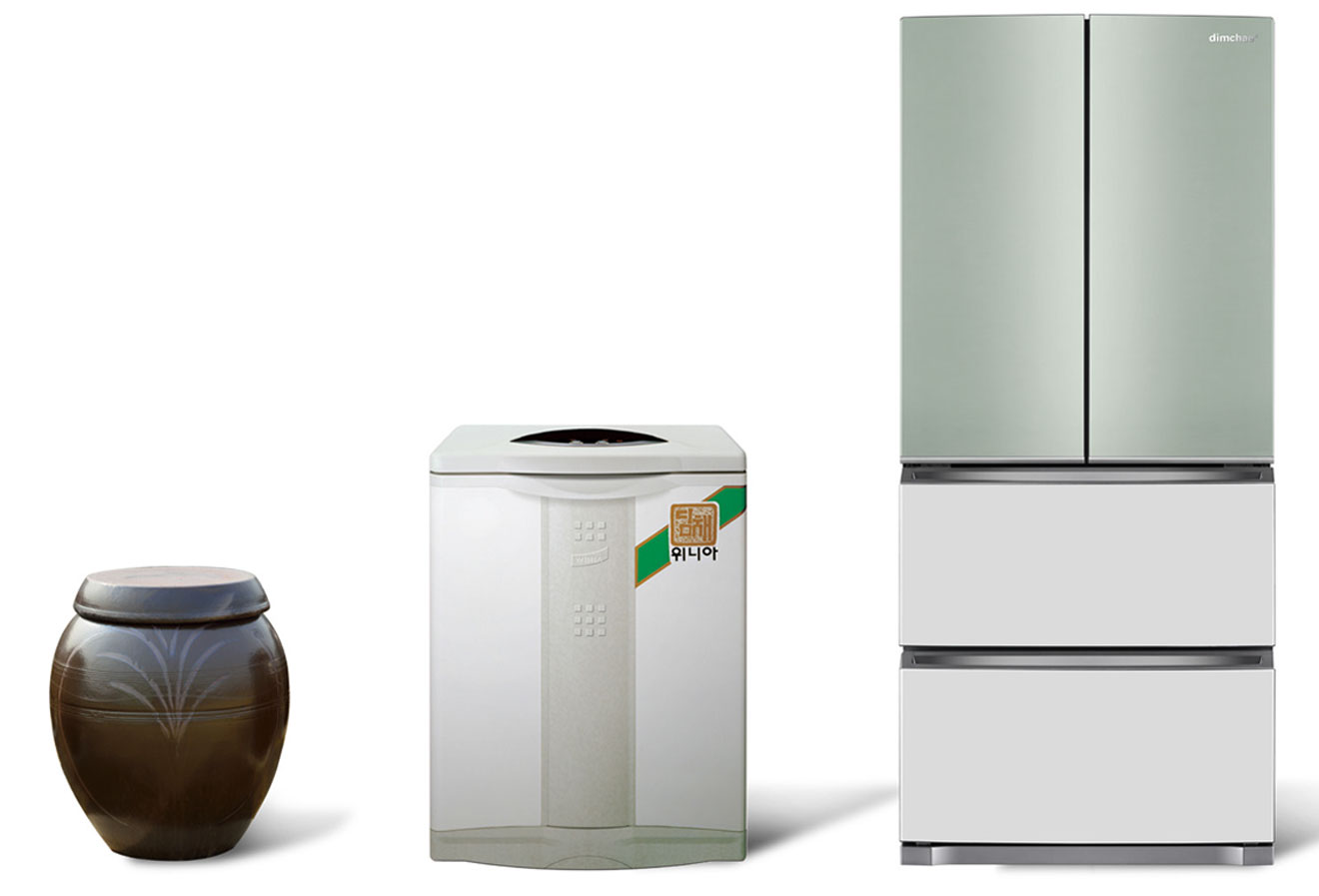November 2021

November 2021
In November of 1995, the “kimchi refrigerator,” a home appliance dedicated to storing kimchi, made its first appearance. The new refrigerator owed its introduction to changes in Korean lifestyles that rendered the clay crocks traditionally used to store kimchi inconvenient to use. The locally developed electrical appliance embodies both traditional culinary culture and modern technology, and has transcended local love for kimchi to become an essential household fixture in most Korean homes.
Written by
Yu Pureum
Photo courtesy of
WiniaDimchae
 © Imagetoday(right)
© Imagetoday(right)
Traditionally, Koreans stored kimchi in clay crocks that were buried underground in winter. The proliferation of apartments and subsequent decline in detached houses, particularly after the Seoul Olympics of 1988, meant burying kimchi was no longer so easy. As kimchi kept in a regular refrigerator went bad after a month, a new storage method was needed. And so was born in 1995 the kimchi refrigerator, a dedicated home appliance for storing kimchi.
To develop the kimchi refrigerator, modernizing the wisdom of the past, when Koreans stored their kimchi in special clay crocks called kimchittok, was vital. “After measuring the temperature under the ground several hundred times to identify the principle of the kimchi crock, we discovered that the underground temperature is a constant ±1C on average,” said Sung Kyoweon, the product planning manager of WiniaDimchae, the company that first popularized the kimchi refrigerator. “To maintain this temperature, we adopted the direct cooling method, which is different from the regular refrigerator’s cooling method using wind. It was a method of cooling the storage itself. Hereby, the kimchi refrigerator, a digital jangdokdae (the space where the clay crocks were traditionally kept) which can preserve the kimchi’s flavor, was born.”
It was also important to research the unique characteristics of the many kinds of kimchi. “Each kimchi has a different method of storage and ripening,” said Seong. “For example, water kimchi has more moisture than other kinds of kimchi, so it is more affected by temperature and ripens much faster. Countless amounts of research and experiments were repeated to reflect these minor details in the kimchi refrigerator.”
 Kimchi storage has evolved from the clay crock to the standing fridge.
Kimchi storage has evolved from the clay crock to the standing fridge.
The kimchi refrigerator has become an essential home appliance in Korea. Over 98% of Korean homes have one. The supply rate is so high that new apartments are designed with a location for the kimchi refrigerator in mind.
The kimchi refrigerator has changed over time, too. One noticeable change is the configuration of the refrigerator. Initially, kimchi refrigerators were horizontal with pull-up lids, imitating the space where the kimchi crocks were stored. Later, they became vertical, free-standing appliances, which are more convenient.
The bigger transformation, however, is the continuous development of functions tailored to the many varieties of kimchi.
There are continuous efforts to reflect the preferences of customers as well. While the early kimchi refrigerator focused on storage, current kimchi refrigerators have a maturation function. “Some people like fresh kimchi that tastes like it was made yesterday, while others prefer thoroughly ripened kimchi,” said Seong. “The current technology of the kimchi refrigerator has reached the point where the fermenting period of one year required for ‘ripened kimchi’ has been shortened to six weeks.”
The kimchi refrigerator now has its sights set on the world market.
“When you study the dietary culture of the world, you find a lot of places have a culture of fermented food like us,” said Seong. “Some examples are sauerkraut, yogurt, cheese, aged meat, tropical fruit and dates. We are planning to make customized products that localize fermentation science as embodied in the kimchi refrigerator, targeting fermented food all over the world.”

Sung Kyoweon
Product Planning Manager
Q. What was the most difficult technology to implement in the early development stage of the kimchi refrigerator, and how did you actualize this technology?
Equalizing the taste of kimchi was the most difficult task. This is because the conditions of the ingredients, the time of making kimchi for winter and the combination of seasonings differ from individual to individual. Creating an algorithm that satisfies the recipes of these individual users was extremely difficult. It involved tremendous legwork by researchers, including visits to must eat places for kimchi all over the country, to famous culinary researchers, to kimchi masters and to regional clan houses. We made kimchi from 1 million heads of Korean cabbage, which was then dataficated.
Q. What was the top consideration in creating the design of the kimchi refrigerator?
It is designed to minimize the physical burden of housewives, being as it is the most widely used product by housewives. It considers aspects such as product depth and size and weight of the kimchi container. Moreover, since the kimchi refrigerator is the most typically “Korean” appliance, we tried to reflect this in its design. For example, the colors of both celadon and white porcelain, which embody the typical beauty and simplicity of Korea, was applied to the products.
Q. Consumption trends and eating trends tend to change over time. What are recent notable changes, and how have these changes been reflected in the kimchi refrigerator?
Dietary culture keeps changing throughout the generations. The function that reflects this change most clearly is the storage function of tropical fruits. This function was added as the consumption of tropical fruits, such as bananas, has grown. In particular, Korea’s dietary culture experienced another huge change recently due to COVID-19. When we studied these changes with product development in mind, we learned that more people enjoy drinking at home, and the interest in immune-boosting foods has increased. By considering these changes, we added a ripening function for makgeolli (rice wine) and fruit syrup to the product released this year.